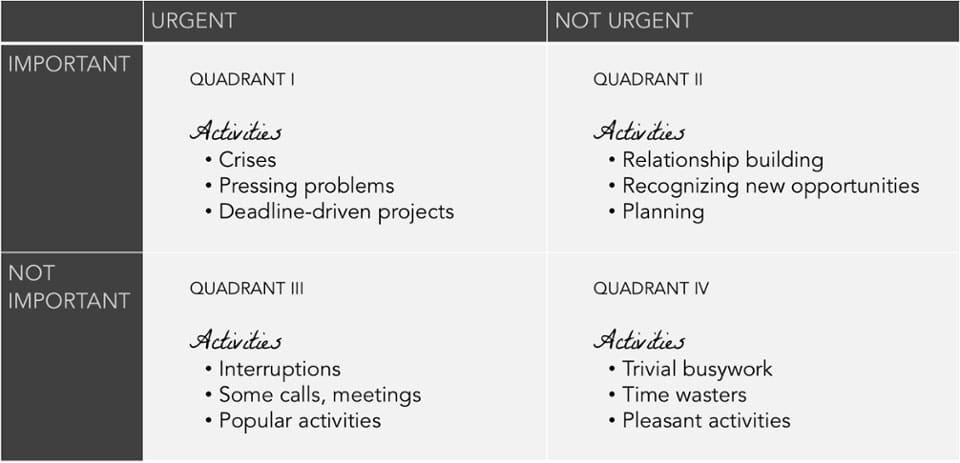Success Advice
How To Use Stephen Covey’s 4 Quadrants To Be Productive
Published
8 years agoon

We all get the same 24 hours in a day so how is it that some people are able to accomplish so much more than the rest of the population? And how can you start doing the same?
One effective principle for doing so comes from Stephen Covey’s bestselling book, The 7 Habits of Highly Effective People.
Even though it was originally published in 1989 a lot the ideas to achieve success are still very relevant, especially Stephen Covey’s 4 quadrants or time management matrix.
By using Stephen Covey’s 4 quadrants you’ll be able to schedule your week according to what’s most important to you and what will have the most meaningful results. It’s introduced as part of Habit 3, “Put first things first,” and it’s designed to help you become a more effective self-manager.
“The challenge is not to manage time, but to manage ourselves.” – Stephen Covey
The Time Management Matrix

As you can see, the two main criteria on which you evaluate tasks are urgency and importance.
The 4 Quadrants Explained
Quadrant 1 – urgent and important
The activities in Quadrant 1 would comprise of things that could not have been forseen and things that could have, if they were planned for.
Quadrant 1 would only contain those activities and responsibilities that require your immediate attention. The space is reserved for emergencies and extremely important deadlines.
The problem is if you spend most of your time managing crises and problems, it’ll keep getting bigger and bigger until it consumes you. This leads to stress, burnout, and constantly putting out fires.
Quadrant 2 – not urgent but important
Quadrant 2 comprises of things that are not urgent right now but important. Things like strategic planning, relationship building, exercise, preparation, education and other personal development activities – all things we know we need to do but somehow seldom get around to actually doing, because they don’t feel urgent.
Quadrant 2 activities are the ones that will really make the difference to your life and help you accomplish a lot more of what you want. This is where highly effective people focus the most.
Quadrant 3 – urgent but not important
The third quadrant would contain items that appear to have a high urgency, but are not at all important. This would be stuff like interruptions, some meetings and phone calls.
Ideally you want to eliminate all of Quadrant 3 by either delegating it out to others or by politely saying No.
If you find that you’re constantly getting interrupted by others then it might be an idea to set up a designated time to deal with such things all in one go to save yourself time.
Quadrant 4 – not urgent and not important
Quadrant 4 activities are basically time wasting activities that are not urgent and offer no value. Quadrant 4 is all about surfing the internet without purpose, wasting time browsing social media, watching endless hours of TV.
Whilst everyone needs a bit of down time and I understand escapism it’s better to have that planned for in your to do list.
Where Do You Spend Most Of Your Time?
If you’re like most people you probably spend most of your time on activities that either fall into Quadrant 1 or Quadrant 3 because they’re urgent.
Covey writes: “Urgent matters are usually visible. They press on us; they insist on action. They’re often popular with others. They’re usually right in front of us. And often they are pleasant, easy, fun to do. But so often they are unimportant!”
Quadrant 2 activities, on the other hand, don’t have the same immediate consequences, so we’re less likely to attend to them.
“THE KEY IS NOT TO PRIORITIZE WHAT’S ON YOUR SCHEDULE, BUT TO SCHEDULE YOUR PRIORITIES.” – STEPHEN COVEY
If you spend more time on Quadrant 2 activities now when they’re not urgent you will minimise the number of Quadrant 1 activities in the future.
A great example of this is exercising. Everyone knows its important to exercise but so few people do because its not urgent right now.
But if you don’t exercise now, eventually it could become urgent if you have a heart attack. You’ll then end up spending even more time in Quadrant 1 dealing with all the health issues that came as a result.
Plus, when you focus on Quadrant 2, it means you’re thinking ahead, working on the roots, and preventing crises from happening in the first place! This helps you implement the Pareto Principle – 80% of your results come from 20% of your time.
How To Use The Time Matrix
The purpose of using the time management matrix is to question whether certain activities bring you closer to your goals or not.
If they do then they need to be prioritised over activities that might demand your time but don’t actually contribute to the achievement of your goals.
This way you’ll end up achieving a lot more of what you want in your life and ultimately be more fulfilled.
There are many ways to use the time management matrix in your life but here are 3 ideas that you can start using straight away:
Prioritise Your To-Do List
You can use the 4 quadrants to prioritise your to-do list. Simply go through your list of activities and identify which quadrant each one falls under.
Then make sure that you’re focusing more of your time doing activities that fall under Quadrant 1 and 2. Try to delay, delegate or eliminate anything that falls under Quadrant 3 and take effective steps to minimise the distractions that could fall into Quadrant 4.
Again I want to clarify that having a bit of planned escapism or down time is not a bad thing, providing its planned. What most people tend to do is just allow all those activities to distract them throughout the day and then wonder where all the time went.
A Weekly Review
Use Steven Covey’s Time Management Matrix to review exactly how your time is being spent so that you can identify where you can make changes for the following week.
- Create 7 blank copies of the time management matrix.
- Record your daily activities in each quadrant and the time spend on each at the end of the day. Do this for each day of the week.
- At the end of the week calculate the total time spend in each quadrant. The goal here is not to judge yourself but to make you aware of where you are spending most of your time and why. Are there any improvements you can make? Can you set up some systems or come up with a better way of doing things?
A Visual Reminder
A third way to use Stephen Covey’s 4 quadrants is to print out the image below (you can find plenty on google images) and stick it somewhere to constantly remind and train yourself where you should be spending most of your time.
Stephen Covey’s 4 Quadrants: The Main Takeaway
The main takeaway here is to take a step back so you can see the difference between how you should spend your time and how you are spending your time.
Then you can make a plan to adjust your schedule so that you allot more time and energy to the activities that will actually produce long-term results, instead of the ones that will produce results five minutes later.
As a consequence, Covey says, you’ll end up with fewer Quadrant 1 activities to deal with: “Your crises and problems would shrink to manageable proportions because you would be thinking ahead, working on the roots, doing the preventive things that keep situations from developing into crises in the first place.”
Did you find this post on using the time management matrix useful?
If you found this post useful then please let me know your thoughts in the comments below and share this post. Also, check out these inspirational Stephen Covey quotes for more timeless wisdom that you can implement into your life.
I'm the Founder of SucceedFeed.com and I truly appreciate you taking the time to read my posts and being apart of the Succeed Feed community. I started this website because I wanted to help people like you to maximize your potential and achieve your dreams. Feel free to reach out and connect. If I can be of any help to you on your journey I'll do my best.










